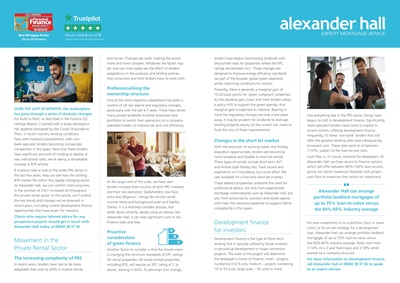
OVER THE LAST 20 MONTHS, the marketplace
has gone through a series of dramatic changes.
For Build to Rent, as described in the Foxtons Q3
Lettings Report, it started with a sharp decrease in
risk appetite prompted by the Covid-19 pandemic.
Then, in recent months, lending conditions
have seen marked improvements, with nonbank specialist lenders becoming increasingly
competitive in the space. Now that these lenders
have significant amounts of funding to deploy at
very well-priced rates, we're seeing a remarkable
increase in BTR activity.
If investors take a look at the wider PRS sector in
the last few years, they can see how the shifting
BTR market fits within this rapidly changing sector.
At Alexander Hall, we can confirm client enquiries
in the summer of 2021 increased all throughout
the private rental sector. In this article, we'll outline
the key trends and changes we've observed in
recent years, including current development finance
opportunities that have arisen for investors.
Clients who require tailored advice for any
prospective projects should get in touch with
Alexander Hall today, at 08000 38 37 36.
Movement in the
Private Rental Sector
The increasing complexity of PRS
In recent years, lenders have had to be more
adaptable than ever to shifts in market trends
and forces. Changes are swift, making the sector
more and more complex. Whatever the factor may
be, one can most easily see the effect of lenders'
adaptations in the products and lending policies
that consumers and their brokers have to work with.
Professionalising the
ownership structure
One of the more impactful adaptations has been a
swathe of UK tax regime and regulatory changes,
particularly over the last 6-7 years. These have driven
many private landlords to either downsize their
portfolios or switch their operations to a companyoperated model, to improve
tax and cost efficiency.
At the larger end of the scale, we have seen
lenders increase their scrutiny of both PRS investors
and their site operators. Stakeholders now face
extra due diligence - things like stricter rental
income ratios and background asset and liability
checks. It is a relatively complex process, but
when done correctly, ideally using an adviser like
Alexander Hall, it can save significant sums in tax,
finance rates and fees.
Proactive
consideration
of green finance
Another factor to consider is that the Government
is changing the minimum standards of EPC ratings
for rental properties. All newly rented properties,
including BTR, will require an EPC rating of C or
above, starting in 2025. To pre-empt that change,
Best Mortgage Broker
(Up to 39 Advisers)
lenders have begun incentivising landlords with
discounted rates for properties where the EPC
ratings are between A-C. These changes are
designed to improve energy efficiency standards
(as part of the broader global green objective)
whilst improving conditions for renters.
Presently, there is generally a marginal gain of
10-20 basis points for 'green compliant' properties.
As the deadline gets closer and more lenders adopt
a policy shift to support the green agenda, that
marginal gain is expected to improve. Bearing in
mind the regulatory changes are only a few years
away, it may be prudent for landlords to leverage
existing property equity (at the current low rates) to
fund the cost of these improvements.
Changes in the short let market
With the evolution of working habits and holiday
staycation opportunities, lenders are becoming
more receptive and flexible to short-let rentals.
These types of rentals include short term AST
and Airbnb style holiday lets. Track record and
experience isn't mandatory, but could affect the
rate available for a first-time short-let investor.
These added complexities underline the need for
professional advice, not only from experienced
mortgage intermediaries such as Alexander Hall, but
also from accountants, solicitors and estate agents
who have the necessary expertise to support clients
competently in this space.
Development finance
for investors
Development finance is the type of short-term
lending that is typically utilised by those involved
in ground-up development or major conversion
projects. The scale of the project will determine
the developer's choice of finance: small - projects
numbering 4 to 9 units, medium - projects numbering
10 to 50 units, large scale - 50 units or more.
Like everything else in the PRS sector, things have
begun to shift in development finance. Significantly,
more specialist lenders have come to market in
recent months, offering development finance.
Frequently, it's these 'non-bank' lenders that will
offer the greatest lending ratio (and subsequently,
increased cost). These rates tend to sit between
7-10%, subject to the loan-to-cost ratio.
Cash flow is, of course, essential for developers. At
Alexander Hall, we have access to finance options
which will offer between 80%-100% loan-to-cost,
giving our clients maximum flexibility with project
cash-flow to maximise their return on investment.
For new investments in to a portfolio (four or more
units), or for an exit strategy for a development
loan, Alexander Hall can arrange portfolio landlord
mortgages of up to 75% loan-to-value versus
the 60%-65% industry average. Rates start from
1.14% on a 2 year fixed basis and 2.59% when
owned via a company structure.
For more information on development finance,
call Alexander Hall at 08000 38 37 36 to speak
to an expert adviser.
We are rated 5 out of 5*
* rating is correct as at the date of production
EXPERT MORTGAGE ADVICE
A B C
Alexander Hall can arrange
portfolio landlord mortgages of
up to 75% loan-to-value versus
the 60%-65% industry average